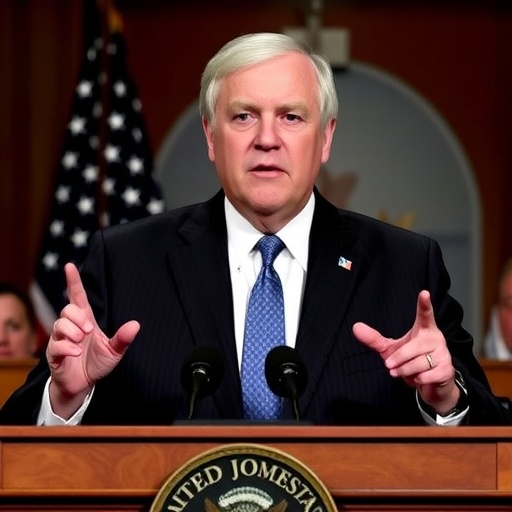Speaker Johnson Warns of Historic Government shutdown Length as Healthcare Standoff Deepens
In a tense address from the Capitol steps today, House Speaker Mike Johnson delivered a sobering prediction: the current Government shutdown could etch itself into U.S. history books as the longest ever, surpassing the 35-day ordeal of 2018-2019. With federal workers furloughed for over three weeks already, Johnson’s words underscore the deepening rift between Democrats and Republicans over healthcare reforms, particularly Democratic insistence on rolling back proposed cuts to health insurance subsidies. As negotiations stall in Washington, the nation’s eyes turn to the human cost of this political impasse.
- Johnson’s Dire Prediction Echoes Through Furloughed Halls of Government
- Democrats Dig In on Healthcare Protections Amid Shutdown Fury
- Polls Reveal Shared Blame as Public Frustration Boils Over
- Republican Leaders Fracture on Healthcare Pathways Forward
- Mounting Pressures Signal Potential Breakthrough or Deeper Crisis
The shutdown, now in its 24th day, has already frozen paychecks for 800,000 essential federal employees and halted services from national parks to food safety inspections. Johnson’s warning comes amid mounting pressure from both sides of the aisle, with polls revealing widespread frustration. “We’re on the brink of a catastrophe that no American signed up for,” Johnson stated, his voice carrying the weight of a divided Congress. This standoff isn’t just about budgets—it’s a battle over the soul of healthcare access in America, where proposed Republican-led cuts to Affordable Care Act (ACA) provisions have ignited fierce opposition.
Behind the scenes, whispers of compromise flicker but fade quickly. Democratic leaders, led by Senate Majority Leader Chuck Schumer, have vowed not to budge without protections for low-income families reliant on subsidized insurance. Republicans, meanwhile, counter with arguments that trimming these programs will curb ballooning federal deficits. As the clock ticks, the potential for a record-breaking shutdown looms larger, threatening economic ripples that could cost the U.S. economy up to $6 billion per week, according to estimates from the Congressional Budget Office (CBO).
Johnson’s Dire Prediction Echoes Through Furloughed Halls of Government
Speaker Johnson’s address wasn’t mere rhetoric; it was a calculated escalation in a high-stakes game of chicken. Standing before a phalanx of reporters, he outlined how the Government shutdown—triggered initially by disagreements over a $1.2 trillion spending bill—has morphed into a proxy war over healthcare. “If Democrats continue to hold the American people hostage over their pet projects, we could see this drag on for 40 days or more,” Johnson warned, referencing the 2018 shutdown’s record under President Trump.
Historical context adds gravity to his claim. The longest prior shutdown lasted from December 22, 2018, to January 25, 2019, costing an estimated $11 billion in lost productivity. Today’s impasse, starting October 1, 2023, stems from a failure to pass a continuing resolution (CR) that would fund operations through the fiscal year. Key sticking points include Republican demands for deeper healthcare reductions, such as capping subsidies that cover 14 million Americans under the ACA, as detailed in the House-passed bill.
Johnson, a Louisiana Republican elected Speaker in a narrow 2023 vote, has navigated internal party fractures to maintain a hardline stance. In private meetings, he reportedly told GOP holdouts that yielding on healthcare would betray their base. Yet, his public tone reveals cracks: “No one wins in a shutdown this long. But we can’t compromise on fiscal responsibility.” Economists at the Brookings Institution project that extending the shutdown could shave 0.2% off GDP growth in the fourth quarter, hitting hardest in sectors like defense contracting and air traffic control.
Federal workers, many working without pay, shared harrowing stories today. Air traffic controller Maria Gonzalez, furloughed from Atlanta’s busy hub, told reporters, “I’ve got bills piling up, and my kids don’t understand why Mommy can’t buy groceries. This isn’t politics—it’s survival.” Such testimonials amplify Johnson’s message, pressuring Democrats to reconsider their red lines.
Democrats Dig In on Healthcare Protections Amid Shutdown Fury
Democrats have framed the government shutdown as a Republican-engineered crisis, pinning blame on Speaker Johnson’s refusal to negotiate in good faith. Senate Minority Leader Hakeem Jeffries fired back during a press conference, declaring, “The GOP’s obsession with gutting healthcare for millions is what’s prolonging this nightmare. We’re fighting for families, not fiscal fantasies.”
At the heart of the dispute are provisions in the proposed budget that would reduce funding for ACA marketplaces by 15%, potentially increasing premiums by an average of $500 annually for middle-class enrollees, per Kaiser Family Foundation analysis. Democrats demand amendments to preserve these subsidies, arguing they prevent 3 million people from losing coverage. Schumer echoed this in a floor speech: “Healthcare isn’t a bargaining chip. It’s a right we’ve fought to expand since 2010.”
Polls underscore the political peril. A recent Quinnipiac University survey found 52% of voters blame both parties equally for the shutdown, with 28% pointing fingers at Republicans and 18% at Democrats. Among independents, disapproval of congressional handling of the crisis hits 65%. This bipartisan backlash has Democrats leveraging public opinion, staging town halls in swing districts to highlight stories of constituents facing medical debt.
One such story: In Ohio, single mother Lisa Ramirez, who relies on ACA subsidies for her daughter’s asthma treatments, joined a virtual rally organized by the Democratic National Committee. “Without this coverage, we’re one emergency away from ruin,” she shared, her words resonating with the 40 million Americans touched by the ACA. Democrats are also invoking the 2022 midterms, where healthcare access propelled their House gains, as leverage in closed-door talks.
Yet, internal Democratic divisions simmer. Progressive caucus members push for bolder expansions, like capping out-of-pocket costs, while moderates urge compromise to end the shutdown swiftly. This tension could either fracture their united front or force innovative concessions, such as phased subsidy adjustments tied to economic triggers.
Polls Reveal Shared Blame as Public Frustration Boils Over
As the government shutdown stretches into uncharted territory, public sentiment has curdled into outright anger, with fresh polls painting a damning picture of congressional dysfunction. A Monmouth University poll released yesterday showed approval ratings for Congress plummeting to 18%, the lowest since the 2018 shutdown. Notably, 61% of respondents believe the impasse will harm the economy, with healthcare cited as the top concern by 37%.
The blame game is bipartisan and brutal. Republicans lead in accusations of fiscal irresponsibility, with 45% of voters in a Fox News survey faulting Democrats for blocking the spending bill. Conversely, CNN’s latest tracking poll indicates 40% hold Republicans accountable for injecting healthcare cuts into must-pass legislation. Speaker Johnson dismissed the numbers as “partisan noise,” but privately, aides admit the optics are toxic ahead of 2024 elections.
Grassroots movements are amplifying the discontent. The nonprofit ShutDownWatch has mobilized 50,000 signatures on a petition urging immediate resolution, while social media trends like #EndTheShutdownNow have garnered 2 million posts. In focus groups conducted by Pew Research, participants expressed exhaustion: “Both sides are playing games while we suffer,” said one Virginia teacher, emblematic of the 70% who want compromise over ideology.
Economically, the toll is quantifiable. The Partnership for Public Service estimates 2.6 million contractors face delayed payments, rippling into small businesses. Travel industry losses from closed parks exceed $300 million weekly, per U.S. Travel Association data. On healthcare, the shutdown delays FDA approvals for 12 new drugs and stalls NIH research grants, potentially costing lives in the long term.
Political analysts like CNN’s Van Jones warn of electoral fallout: “This could flip 10 House seats if it drags on.” With midterms looming, both Democrats and Republicans are recalibrating strategies, from targeted ads highlighting opponents’ intransigence to outreach in battleground states.
Republican Leaders Fracture on Healthcare Pathways Forward
Within the Republican ranks, unity on the government shutdown and healthcare is fracturing, exposing ideological chasms that could doom negotiations. Speaker Johnson champions a “repeal and replace” lite approach, advocating for block grants to states in lieu of ACA subsidies—a move decried by Democrats as a backdoor to dismantling protections.
Senate Minority Leader Mitch McConnell, ever the pragmatist, has signaled openness to tweaks, telling reporters, “We need a path that saves face for everyone.” This contrasts with hardliners like Freedom Caucus Chair Bob Good, who insists, “No deal without real cuts. The deficit is $34 trillion—healthcare bloat must end.” Such discord played out in a closed GOP conference, where 20 members reportedly urged Johnson to drop healthcare riders entirely to avert disaster.
Expert voices weigh in heavily. Heritage Foundation’s Kay Coles James supports Republican positions, arguing subsidies distort markets and inflate costs by 20%, citing CBO projections. Conversely, the American Medical Association warns that cuts could uninsured rates by 5 million, exacerbating hospital strains post-COVID.
Potential olive branches emerge: Bipartisan talks floated a six-month CR with frozen healthcare funding, but veto threats from the White House scuttled it. Johnson, in an op-ed for The Wall Street Journal, called for “principled compromise,” hinting at work requirements for subsidies—a nod to conservative priorities that might entice Democrats.
State-level impacts add urgency. In Republican-led Florida, Governor Ron DeSantis has warned of $1 billion in lost federal aid, urging Congress to act. These pressures could coalesce into a breakthrough, but with factions entrenched, the path remains thorny.
Mounting Pressures Signal Potential Breakthrough or Deeper Crisis
As the government shutdown barrels toward infamy, forward-looking signals point to a precarious balance: either a fragile truce or escalation into economic peril. White House officials, including Press Secretary Karine Jean-Pierre, have ramped up calls for Republicans to “put people over politics,” scheduling emergency sessions with Speaker Johnson for next week.
Implications extend far beyond Washington. Moody’s Analytics forecasts a 0.5% unemployment spike if the shutdown hits 40 days, with healthcare providers facing $2 billion in unpaid claims. Internationally, allies like the EU express concern over U.S. instability, potentially weakening trade talks.
Optimists point to precedents: The 1995-1996 shutdowns ended via mutual concessions. Bipartisan groups, including the Problem Solvers Caucus, are drafting a hybrid bill preserving core ACA elements while trimming administrative costs by 10%. Johnson has nodded to such efforts, saying, “Real solutions require courage from all sides.”
Yet, risks loom. If no deal by month’s end, Treasury could miss debt payments, triggering a credit downgrade. For families, the human stakes are stark: 500,000 children in WIC programs face nutritional gaps. As negotiations resume, the nation holds its breath—will Democrats and Republicans forge peace, or will history record a shutdown of unprecedented pain?









